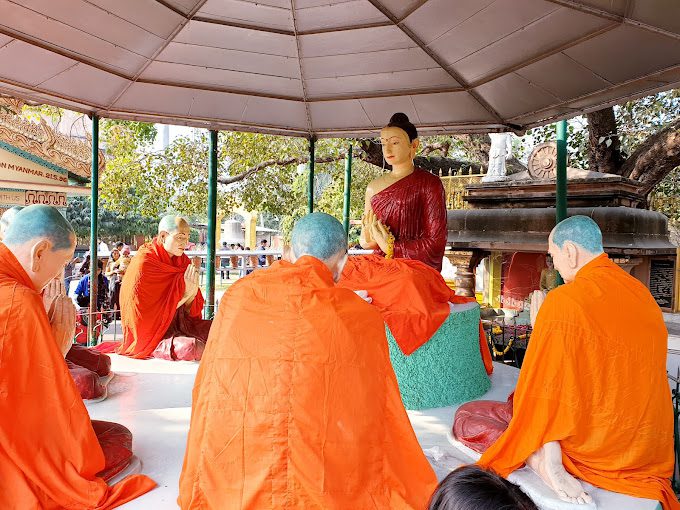Sarnath Buddhist Temple:
Sarnath, also known as Sarangnath, Isipatana, Rishipattana, Migadaya, or Mrigadava, is a location in Uttar Pradesh, India, 10 kilometres northeast of Varanasi, close to the confluence of the Varuna and the Ganges rivers.
Following his enlightenment in Bodh Gaya, Gautama Buddha gave his first sermon in Sarnath. The awakening of his first five followers led to the establishment of the Buddhist sangha there as well (Kaundinya, Assaji, Bhaddiya, Vappa and Mahanama). The Buddha named Sarnath as one of the four pilgrimage sites his devoted disciples should visit and regard with reverence in the Mahaparinibbana Sutta (Sutta 16 of the Digha Nikaya). The other three locations are Kushinagar, where the Buddha acquired enlightenment, Bodh Gaya, where he was born, and Lumbini (where the Buddha attained parinirvana).
The Sanskrit term Saranganatha (or Srangnath in the Pali language), which in English means “Lord of the Deer,” is where the name Sarnath originates. The name alludes to an old Buddhist legend in which a Bodhisattva disguised as a deer offered to sacrifice himself for a king in place of the doe the monarch intended to slaughter. The park was established by the king as a deer sanctuary because he was so affected. Mriga-dva, also known as Miga-dya in Pali, is the Sanskrit or English translation for “deer park.”
Sarnath is also known as Isipatana in Pali, the language of the Pali Canon. The Sanskrit name Rishipattana is equivalent to this name. An accomplished and enlightened individual is referred to by the terms isi (Pali) and rishi (Sanskrit). Therefore, Isipatana and Rishipattana mean “the site where holy men plummeted” and “the hill of the fallen sages,” respectively.
Sarnath Temple History:
The Buddha named Sarnath as one of the four pilgrimage sites his devoted disciples should visit and regard with reverence in the Mahaparinibbana Sutta (Sutta 16 of the Digha Nikaya). Ancient sites like Sarnath have been the focus of in-depth archaeological research and restoration since the late 18th century. As a result, Sarnath is once again a popular pilgrimage destination for Jains and Buddhists alike. Sarnath was proposed in 1998 for listing on the World Heritage Sites of Outstanding Universal Value to Cultural Heritage list by the UNESCO.
The Chaukhandi Stupa represents group “A” in the nomination, which consists of two groups of monuments, whereas group “B” is made up of all other monuments. Buddhist pilgrims place the greatest attention on the following sites: With a diameter of 28 metres (92 feet) and a height of 39 metres, the Dhamek Stupa is a striking building.
One of the few pre-Ashokan stupas still standing in Sarnath is the Dharmarajika Stupa, but only the foundations are visible. From the late 18th through the early 20th centuries, it was the target of significant looting and archaeological excavations.
The Ashokan pillar that was built here was destroyed during the 12th-century invasions, although many of the parts are still at the original site. The Lion Capital of Ashoka, which served as the basis for a massive 32-spoke sandstone wheel of dharma, formerly stood atop the pillar. The wheel of dharma and the lion capital, which are currently on display at the Sarnath Archeological Museum, represent modern India. The wheel of dharma is a part of the Indian flag, and both of these are depicted on the seal of the Supreme Court of India.
Sarnath Temple Timings:
The timings of Sarnath Buddhist Temple is 8.00 am – 5.00 pm
Sarnath Museum:
The Archaeological Survey of India’s Sarnath Museum is the organization’s oldest site museum. It houses the results of the Archaeological Survey of India’s excavations at the Sarnath archaeological site.
The museum has five galleries and two verandahs where artefacts from Sarnath dating from the third century BCE to the 12th century AD are shown. Many statues, artefacts, and buildings, including numerous images of the Buddha and Bodhisattva, have been discovered in Sarnath. The museum has been home to some of the finest examples of Buddhist art as well as other significant artefacts.
The Lion Capital of Ashoka is the museum’s most well-known piece, although it also has a variety of other Buddhist treasures. A Buddha statue from the fifth century is one of the sights to view. The Buddha is seated cross-legged, his eyes closed in intense meditation, and he is surrounded by a halo. The many bodhisattva figures are also interesting to examine.
Sarnath Museum Timings: 9.00 am – 5.00 pm (friday closed)
Sarnath Museum Ticket Price :
Entry Fee: Rs. 5 per person
Children under the age of 15 are admitted free of charge (Free Entry fees children up to 15 years)
There is a guide service.
Sarnath Official Website: http://www.sarnathmuseumasi.org/
Sarnath Museum Contact Number : 0542 259 5095
Best time to visit Sarnath: October to March
How to reach Sarnath Temple:
By Air: Sarnath is located around 25 kilometres from Varanasi, the city with the closest airport.
By Train: Varanasi Railway Station is not far from Sarnath, which has its own railway station. The best option is to disembark at Varanasi Junction because few trains stop at Sarnath Railway Station. To go to the city of Sarnath, you can take a taxi or cab.
By Road: Due to its close proximity to Varanasi, Sarnath has excellent road connections. To travel to Sarnath, take a bus from Varanasi.
Places to visit in Sarnath temple Varanasi:
Dhamek Stupa
Mahabodhi Society Temple
Chaukhandi Stupa
Thai Temple
Tibetan Temple
Ashola Pillar
Sarnath Temple Photos:





